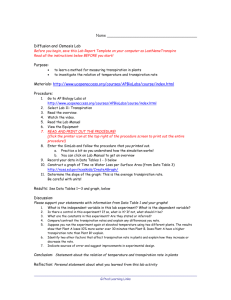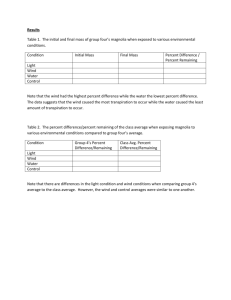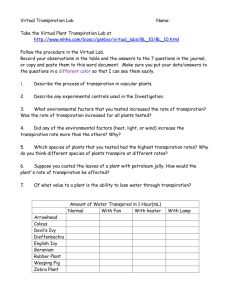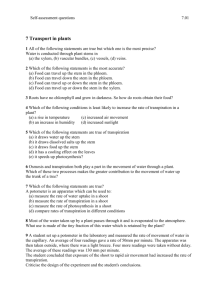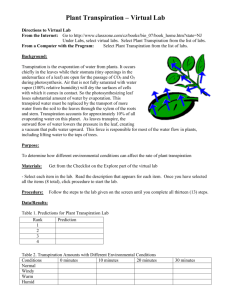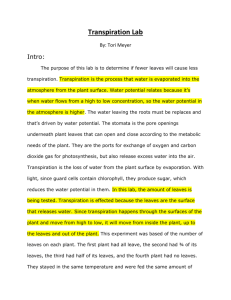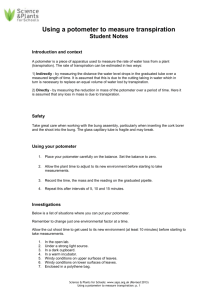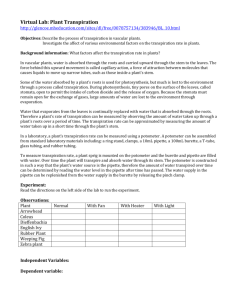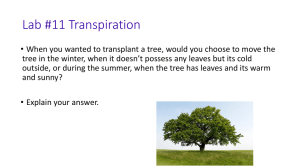File
advertisement
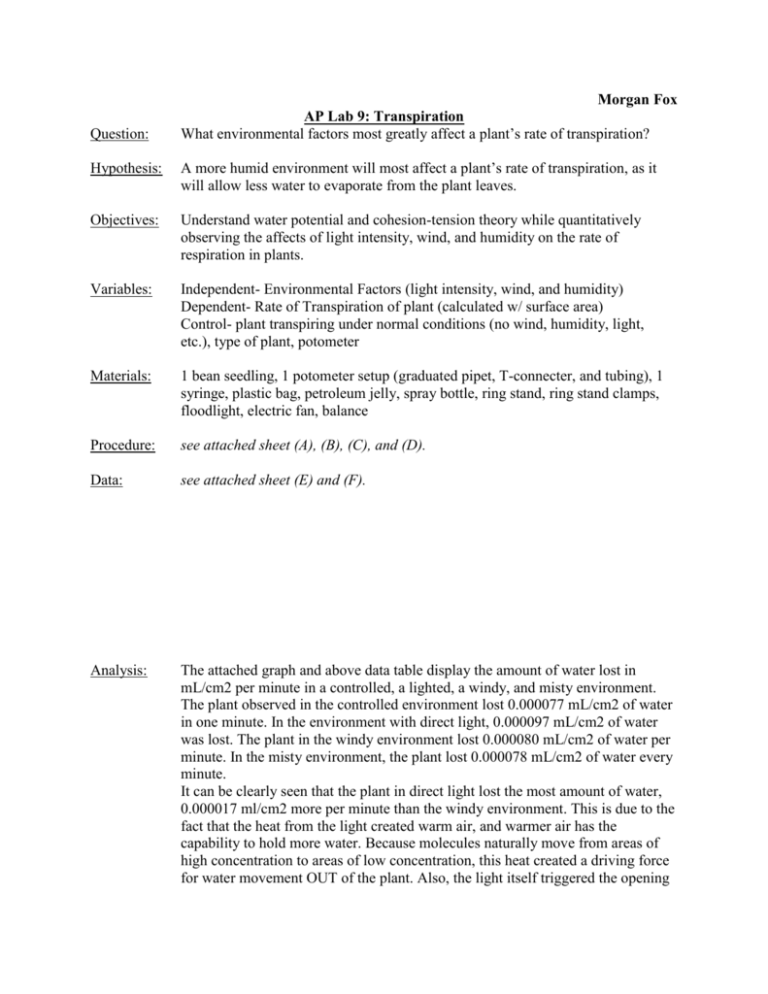
Morgan Fox Question: AP Lab 9: Transpiration What environmental factors most greatly affect a plant’s rate of transpiration? Hypothesis: A more humid environment will most affect a plant’s rate of transpiration, as it will allow less water to evaporate from the plant leaves. Objectives: Understand water potential and cohesion-tension theory while quantitatively observing the affects of light intensity, wind, and humidity on the rate of respiration in plants. Variables: Independent- Environmental Factors (light intensity, wind, and humidity) Dependent- Rate of Transpiration of plant (calculated w/ surface area) Control- plant transpiring under normal conditions (no wind, humidity, light, etc.), type of plant, potometer Materials: 1 bean seedling, 1 potometer setup (graduated pipet, T-connecter, and tubing), 1 syringe, plastic bag, petroleum jelly, spray bottle, ring stand, ring stand clamps, floodlight, electric fan, balance Procedure: see attached sheet (A), (B), (C), and (D). Data: see attached sheet (E) and (F). Analysis: The attached graph and above data table display the amount of water lost in mL/cm2 per minute in a controlled, a lighted, a windy, and misty environment. The plant observed in the controlled environment lost 0.000077 mL/cm2 of water in one minute. In the environment with direct light, 0.000097 mL/cm2 of water was lost. The plant in the windy environment lost 0.000080 mL/cm2 of water per minute. In the misty environment, the plant lost 0.000078 mL/cm2 of water every minute. It can be clearly seen that the plant in direct light lost the most amount of water, 0.000017 ml/cm2 more per minute than the windy environment. This is due to the fact that the heat from the light created warm air, and warmer air has the capability to hold more water. Because molecules naturally move from areas of high concentration to areas of low concentration, this heat created a driving force for water movement OUT of the plant. Also, the light itself triggered the opening of stomata, which allows carbon dioxide to be available for the photosynthetic process. These open stomata allowed more water to exit the leaf, thus overall increasing the amount of water lost per minute. The plant in the misty environment lost the least amount of water. As air can only hold so much water, more humid conditions decrease the rate of transpiration in plants. The water in the leaves and on the leaves’ surfaces has no place to go, so the pull of more water up the xylem from the ‘roots’ slows down. The amount of water lost per minute for this plant probably should have been quite a bit lower, but a flaw in the potometer, the readings of water levels, or the mathematical determination of water lost per minute may have contributed to a miscalculation. The windy environment caused the plant to loose the second most amount of water per minute. As there is naturally a layer of water vapor coating leaves’ surfaces (a boundary layer), wind allows transpiration to increase as it alters and/or removes this still layer, making an easier and shorter path directly to the atmosphere. Conclusion: My hypothesis should be rejected based on these findings, as my initial hypothesis of humidity having the greatest affect on plant transpiration was incorrect. Plant transpiration is clearly most greatly affected (according to this data set) by light. This makes sense as light is almost always accompanied by heat, and both of these factors drive transpiration in different ways. Light speeds up transpiration by opening the stomata and some sources (Oxford Journals) claim that a leaf may transpire three times faster at 30 degrees Celsius than it does at 20 degrees Celsius. Heat in optimal ranges allows water to evaporate very quickly, drawing more water up the xylem by the properties of adhesion (water’s ability to stick to other molecules) and cohesion (water’s ability to stick to itself). It is important to bear in, however, that there may have been a miscalculation in the water loss of the plant in the misty environment. An additional experiment may yield results that depict a much greater difference between the water loss in the control plant and the misted plant. Abstract I measured the amount of water lost in plants in four different environments (misty, windy. lighted, and controlled) and calculated the amount of water lost per minute in each environment. I did this to determine which environmental factor has the largest affect on the rate of transpiration in plants. I found that the plant in the lighted environment lost the most amount of water per minute, and the controlled plant lost the least. When light (and therefore heat) is present, the plant’s stomata open in response to the presence of light in order to take in carbon dioxide for the photosynthetic process. The heat causes evaporation to occur much more rapidly (similar to how humans sweat more in hotter weather). As the controlled plant had an unaltered boundary layer, only a moderate amount of light, and standard humidity conditions, it lost less water than both the lighted and windy environments, and about the same as the misty environment.

